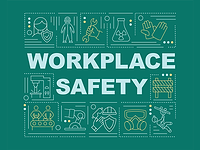How to Kill a Blast Room in 7 Easy Steps

Image courtesy of Titan Abrasive Systems.
So, you’ve got yourself a blast room. Maybe it was a solid investment at first—saving time, reducing outsourcing costs, and giving you control over operational quality. But now, you’re over it. It’s noisy, dirty, and constantly demanding attention. If only there were a way to speed up its inevitable decline…
Good news! With just a few “strategic” decisions (or lack thereof), you can run that blast room into the ground in no time. Repairs will pile up, efficiency will plummet, and downtime will skyrocket. If you're aiming for a complete system shutdown, follow these seven foolproof steps, and you’ll be on your way to blast room catastrophe.
1. Keep Using Those Filthy Filters – Forever
Filters are designed to catch dust and contaminants, but that doesn’t mean you actually need to change them, right? You’ve got a dust collector with self-cleaning filters—let it do its thing! Ignore the fact that these filters eventually clog up, restricting airflow and forcing your system to work harder. Some people replace their filters when they start losing efficiency. Amateurs. You? You’re playing the long game. Keep those filters in use until the dust collector is about as effective as a clogged vacuum cleaner. When your blower motor finally sucks a hole through a deteriorated filter and turns into a dust-inhaling wreck, you’ll have the perfect excuse to spend thousands on repairs.
For an extra challenge, send your filters out for professional cleaning instead of replacing them. Over time, the material will weaken like an old T-shirt after too many washes. When the filters eventually fail, the damage to your system will be all the more dramatic.
2. Buy the Cheapest Filters You Can Find
Not only should you use filters for as long as possible, but when you do finally cave and buy new ones, make sure they’re the cheapest ones available. After all, it’s just a filter—what could possibly go wrong? High-quality filters have strong materials and high MERV ratings to trap fine particles. But let’s be real: the lower the MERV rating, the faster dust and contaminants can escape back into your system. And isn’t that what we’re going for?
With budget filters, you’ll enjoy a shorter lifespan, more frequent replacements, and plenty of fine dust coating your equipment. Efficiency, health and safety? Overrated. Bonus points if your entire team starts coughing by lunchtime!
3. Ignore Equipment Wear – If It Ain’t Broke (Yet), Don’t Fix It
Let’s talk about your hoses, nozzles and ductwork. Sure, they’re exposed to high-speed abrasive media on a daily basis, but does that really mean they need checking? We think not. After all, nozzles, hoses and ductwork are just suggestions, not critical components. Blasting nozzles wear down over time, affecting pressure, efficiency and material usage. But replacing them is just another unnecessary cost, right? Ignore the signs of wear—like reduced blasting power or an uneven spray pattern—and keep pushing that equipment to the breaking point. Forget about those fancy carbide-lined nozzles; just keep blasting with the cheapest parts available until your system collapses in a glorious, dust-filled finale.
And don’t even think about upgrading to carbide-lined nozzles, which last longer and perform better. Stick with the cheapest, weakest materials so you can experience the excitement of sudden nozzle failure in the middle of a job. Nothing says productive work environment like a team scrambling to deal with unexpected equipment breakdowns.
4. Skip Housekeeping – Who Needs Clean Floors?
Housekeeping is a waste of time. Everyone knows that blast rooms are supposed to be dirty. Let the dust fly! Don’t bother waiting for the dust collector to clear the air before opening the doors—just fling them open and enjoy the majestic cloud of airborne particles cascading into your facility. Forklifts tracking abrasive media throughout the shop? So what? Why sweep up loose media when you can let it spread everywhere? The occasional slip-and-fall accident or clogged machinery just adds to the excitement.
For an extra challenge, remove all brooms and shop vacs from the vicinity. Workers will eventually give up on cleaning altogether, and your facility will take on the ambiance of an abandoned construction site.
5. Let Your Hanger Bearings Grind to Their Inevitable Doom Hanger bearings are critical for keeping your auger in place and preventing metal-on-metal grinding. But instead of checking them regularly, just assume they’ll hold up forever.
When a hanger bearing wears out, the auger drops lower and starts scraping the trough. At first, it’s just a slight noise. Then it’s a full-blown metal-on-metal grinding session. Eventually, the auger will carve a hole through the bottom of the trough, sending a beautiful waterfall of abrasive media straight onto the floor.
6. Overload the Media Reclaim System – It Can Handle It!
Your mechanical reclaim system is designed to process a steady stream of spent media. But if you’re looking to kill your blast room, go ahead and dump an entire day’s worth of abrasive media onto the auger all at once. Why wait for a controlled feed when you can overload the system in seconds? The auger will jam, the motor will struggle, and eventually, something critical will fail. It’s like a stress test, except you’re guaranteeing failure instead of preventing it. For extra fun, ignore any control systems that prevent premature operation. Just force the system on and see what happens. Spoiler alert: nothing good.
7. Skip Those Annoying Inspections – Who Has Time for That?
Routine inspections are for people who like to keep things running smoothly. You’re aiming for chaos. So why bother checking for cracked glass, broken seals or malfunctioning PPE? Visual inspections are for overachievers.
Windows and door seals? Who cares if there are gaps? Just let dust escape and contaminate everything in sight. PPE in questionable condition? Just roll with it—what’s a little compromised air supply among friends?
When things do go wrong, you’ll get to enjoy a full-scale equipment failure, which is way more exciting than catching small issues early. And as a bonus, you can blame the workers for not noticing the problems sooner.
The Blast-Room Failure Guarantee
A properly maintained blast room can last for years, keeping operations efficient, costs down and downtime minimal. But where’s the fun in that? By following these simple steps—ignoring maintenance, buying the cheapest parts and embracing operational chaos—you can transform your blast room into an expensive, broken-down liability in record time.
So, what’ll it be? Will you let your blast room live a long and productive life, or will you speed up its demise with poor decisions and negligence? The choice is yours… but if you’re reading this, it’s highly likely that you already know what to do.
Looking for a reprint of this article?
From high-res PDFs to custom plaques, order your copy today!






